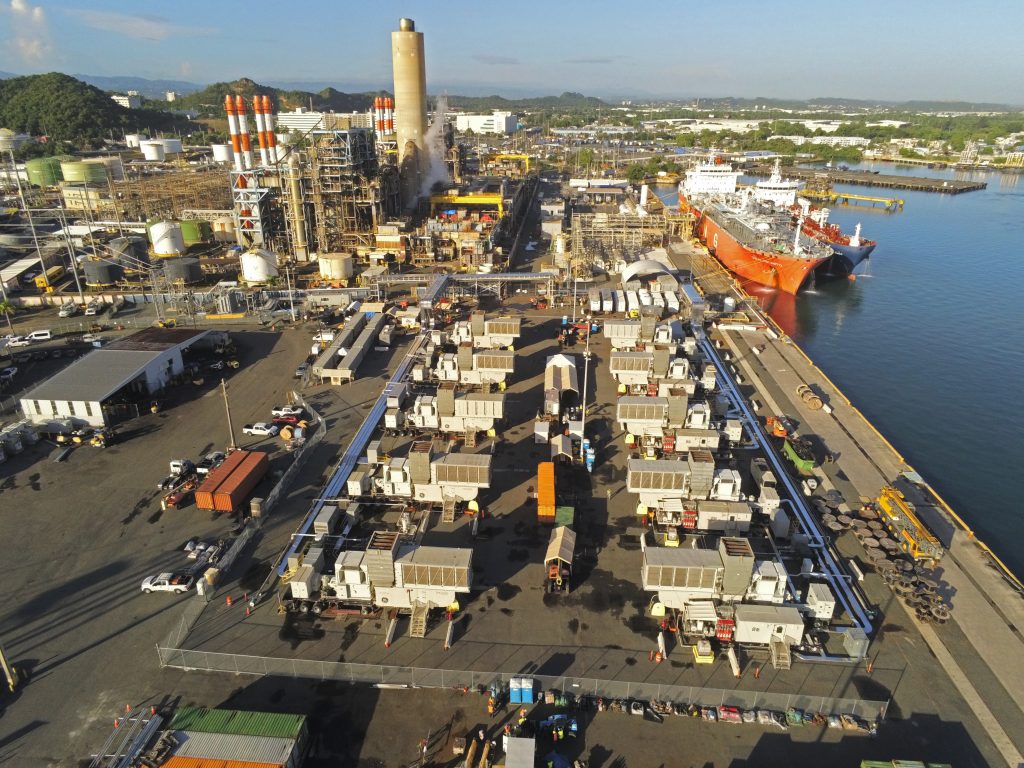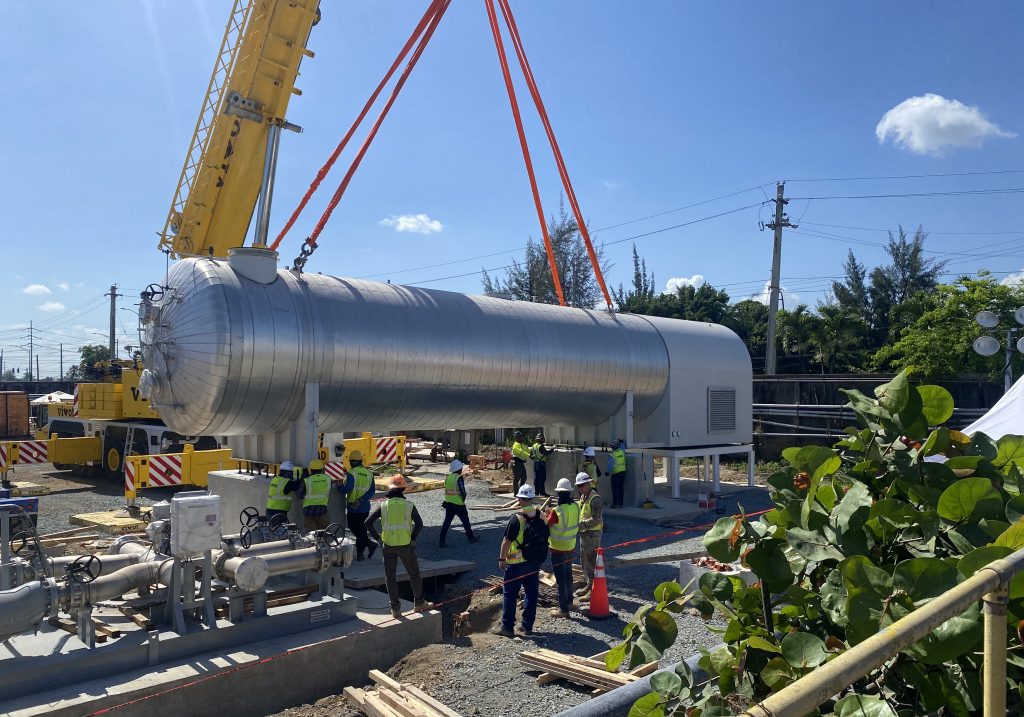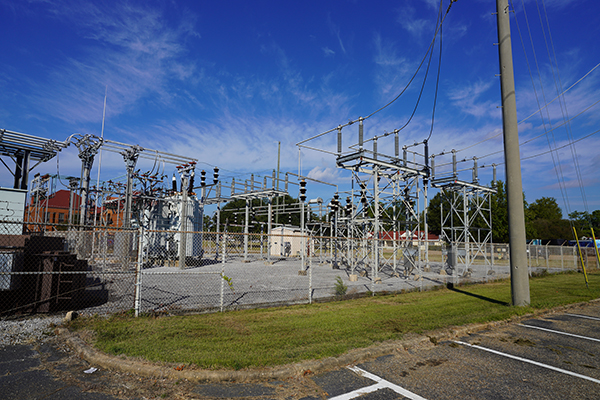By Chris Henry and Chris Young, PMP
Following Hurricane Fiona in 2022, the time-critical construction, installation, and short-term operation of temporary power at Palo Seco Power Plant and San Juan Power Plant was crucial to restoring essential services.

U.S. Army photo by Samuel Weldin
In September 2017, Puerto Rico endured two catastrophic hurricanes: Hurricane Irma, a Category 5, and Hurricane Maria, a Category 4. Devastation to critical infrastructure, specifically the electrical grid, left some residents without power for a year, and the grid never fully recovered.
The fragility of Puerto Rico’s still-mending electrical infrastructure was again laid bare by Hurricane Fiona in August 2022. The storm caused additional outages that exacted a heavy toll on frontline communities, further disrupting electricity, water, healthcare, and transportation, and ultimately, impacting the overall economy and livelihoods of residents.
Restoring power to Puerto Rico this time would require a dedicated team of federal and commonwealth agencies, partnering with industry, to meet a critical short-term deadline.
Swift Deployment
After Hurricane Fiona, a Presidential Declaration was issued to stabilize the grid, which led to the formation of the Puerto Rico Power System Stabilization Task Force. This organization consisted of the Federal Emergency Management Agency, Environmental Protection Agency, Department of Energy, and U.S. Army Corps of Engineers (USACE), together with agencies from the Commonwealth of Puerto Rico.
Under the Rapid Disaster Infrastructure Contract, USACE selected Weston Solutions to provide 150-MWs of temporary power at the Palo Seco Power Plant and 200-MWs of temporary power at the San Juan Power Plant. At each site, upwards of 250 personnel were mobilized, working round-the-clock shifts and amassing a combined 400,000 safe labor hours to install power generation equipment and support infrastructure.
Collectively, the generators at both plants supply 350-MWs of power. This equals the power supply for over 260,000 residences, approximately 1 million Puerto Ricans. The generators primarily run on liquified natural gas but they can transition to diesel if needed in the event of supply chain disruptions. This capability ensures power supply reliability when most needed.
Logistics and Installation
The project team accomplished all procurement and transportation tasks at each site within 30 days, a process that usually takes several months. Once the cargo reached Puerto Rico, the team promptly transported the generators, balance of plant equipment, and comprehensive liquified natural gas regasification and distribution facilities to the necessary locations. Road transportation of heavy equipment required securing permits from various jurisdictions.

A notable example was the overnight transportation of a 90,000-gal (273,000-lb) gas storage tank, which traversed a major highway over a 7-mi distance, necessitating multiple traffic closures.
Substantial Scope. Following site surveys just days after each contract award, field personnel began preparing support infrastructure and installing the gas turbine packages and balance of plant equipment. Critical lifts, including the gas storage tank at the Palo Seco plant, were conducted. Additionally at Palo Seco, the regasification and distribution facility was constructed. This enabled liquified natural gas to be offloaded, transferred to the tank, and converted into a gaseous form. The gas then was pumped through pipelines to the generators.
Across both plants, a significant amount of piping and cables were installed: 3,600-linear-ft of diesel pipeline; 4,075-linear-ft of natural gas pipeline; and 13.5-mi of medium voltage cable. For load distribution of the turbine-generator sets, steel plates were placed underneath each jacking gear. Cranes were used to position the exhaust stacks, inlet filter sections, and balance of plant equipment onto the skids. The main control systems were installed, tested, and commissioned to local utility standards. Other infrastructure, including cable trays, supports, and ramps, were installed to connect the extensive power and control cabling from the equipment to the existing utility distribution system. Subject matter experts verified that all installation tasks were performed according to incidental design deliverables.
Ensuring Performance. Along with installing of the generators, transformers at both sites required recommissioning or replacing. At Palo Seco, three existing transformers needed recommissioning and system checkout prior to connecting them to the seven commissioned generators. As each transformer differed in megawatt capacity, the generators were configured to meet the required 150-MWs. At San Juan, an existing transformer was found unusable and needed replacement. A new 336-MVA transformer weighing 173-T (equivalent to a Boeing 747-400) was relocated and installed at the San Juan site. A total of seven high-voltage power poles were installed to support the new 115-kV transmission line, which allowed for transmission of high-voltage power from the generators to the grid. For hurricane resilience, these poles were buried 15-ft deep and reinforced with 45-yd³ of concrete.
To support generator installation and meet the accelerated timeline, field crews at Palo Seco and San Juan began partial load testing and commissioning of two units at a time. In the end, all units at each site were tested at their full capacity.

Ongoing Oversight. In May 2023, the team successfully commissioned the generators (six primary units, with a spare mobilized and commissioned in June 2023) at the Palo Seco plant. Collectively, they achieved an average net continuous output of 153-MW, surpassing the required 150-MW. In September 2023, the team completed the commissioning of 10 generators (nine primary and one spare) at the San Juan plant, providing the needed 200-MWs of power. Both plants are showing an excellent online efficiency, with Palo Seco at over 98 percent and San Juan above 99 percent. These achievements represent a significant milestone that required the collaborative efforts of hundreds of individuals over an extended period to ensure successful project execution.
Currently, dedicated crews manage and oversee operations and maintenance at each site and will continue doing so until March 2024. Palo Seco relies on approximately 50 truck deliveries of 10,000-gal of liquified natural gas each day. The gas is then regasified on-site using the regasification facility constructed at the plant. Alternately, the San Juan facility pipes natural gas directly from an adjacent terminal. This terminal uses a 7-million-gal floating storage barge to transport liquified natural gas to the commonwealth. These site-specific strategies efficiently use the available infrastructure.
Grid Resilience
In the ongoing effort to restore power and enhance energy resilience in Puerto Rico, the temporary power restoration is a critical step in securing the overall grid.
This project is just one of many aimed at building a more resilient energy grid across the island, ensuring its ability to withstand unpredictable storms and support its citizens.
Reducing Emissions
With a goal of no more than 25-ppm of nitrogen oxide emissions, a modification was issued to incorporate a demineralization water system into the generator units at both plants (San Juan and Palo Seco). Demineralized water is required to prevent the accumulation of minerals within sensitive generator components, similar to the buildup in a shower head that can decrease water pressure.
Injecting this demineralized water into the combustors through fuel nozzles results in a significant reduction of nitrogen oxide emissions. The demineralized water system uses ultra-filtration/multimedia filtration, reverse osmosis, and ion exchange equipment to convert potable water into demineralized water, which is pumped to the gas turbines.
Chris Henry is Vice President, Client Sector Leader, and Chris Young, PMP, is Vice President, RCO Operations Manager, Weston Solutions. They can be reached at chris.henry@westonsolutions.com; and chris.young@westonsolutions.com.
More News from TME
-

Electrifying Solutions for Military Installations
As military installations implement electrification measures into the future, the challenges they face will not just require innovative technology solutions but embracing a holistic delivery approach implemented early in projects. -

Providing Benefits Through Adaptive Reuse of Federal Assets
Reconfiguring existing sites or buildings for a new mission has many inherent advantages to solve challenges that face federal entities, but key considerations need to be accounted for in order to maximize value. -

Driving Resilience Decisions Through Better Data
The Air Force Office of Energy Assurance is demonstrating how a new iteration of resilience assessments can better target and quantify potential vulnerabilities in energy security—bolstering national defense by supporting more informed decisions on resilience improvements at installations.